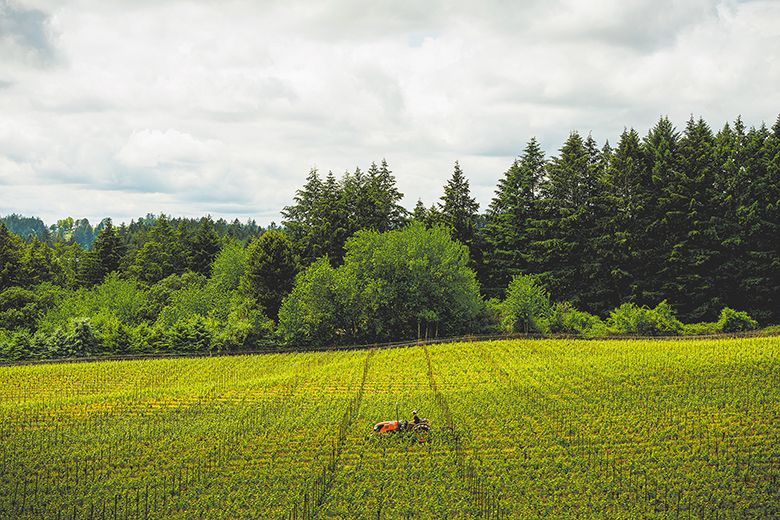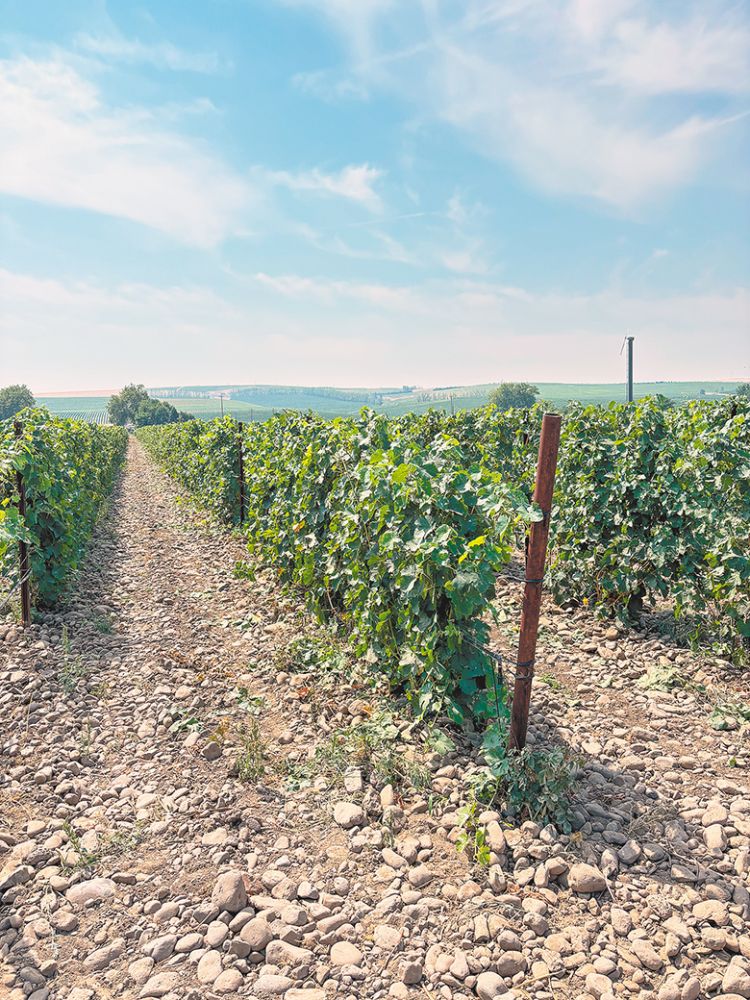Que Syrah, Syrah
Meet several Oregon producers crafting unique wines with the variety



By Tamara Turner
Although Oregon Syrah may not have the same following as Pinot Noir, it’s making waves in the wine world. Savvy consumers discovered our state’s expressions of Syrah emphasize the wine’s purity and elegance. The secret is, the variety performs best in our more moderate climates.
Devoted fans are enchanted by the grape’s distinctive and unique characteristics. High-alcohol fruit bombs from hot growing regions produce jammy, chocolatey, simple wines. Yet, Syrah planted in the proper area runs the gamut from elegant and complex to savory, saline or even sanguine, remaining fruity and floral.
Oregon’s cool and moderate-climate regions produce extraordinary Syrah. The Rocks District of Milton-Freewater rapidly developed a cult following. Moreover, Southern Oregon and the Willamette Valley highlight their unique region’s terroir, shaping the wine with specific characteristics and distinctive flavor profiles. I overheard one person say, “Oregon’s Syrah’s are so good, they’re worth fighting over.”
Moderate-Climate Syrah
Though different in style, both Walla Walla Valley’s The Rocks District and Southern Oregon represent Oregon’s moderate-climate Syrah. With higher temperatures and longer growing seasons, the two areas receive more sunlight, allowing the fruit to fully ripen. The result? Rich, bold, expressive wines with natural acidity, masterfully highlighting the particular soil composition, elevation and microclimates where they grow best.
Abacela’s CEO Greg Jones says, “Extensive research determined Syrah would do well at our site in the Umpqua Valley (known for Tempranillo), based on the climate and our hillside vineyard.” The winery first planted the variety in 1995. Abacela has more than nine acres today. They find it always ripens well at their site. Abacela’s Syrah proved so successful it became Southern Oregon’s first wine to earn 95 points from Wine Enthusiast.
Depending on the vintage, the wine ranges from more delicate to layered and complex. Either way, expect elegant tannins with a lush, generous finish. The site consistently brings out darker fruit flavors like blackberries and plums with aromas of spice and either floral or herbal notes. Jones describes these scents as “natural matorral or garrigue plant mix.”
Farther south… “The Applegate Valley is neither a warm cool-climate nor a cool warm-climate region,” says Nate Wall, winemaker at Troon Vineyard. “We can indeed experience a couple days of triple-digit heat most summers, yet our diurnal variation between night and day creates a moderating influence on these high temperatures.”
Winegrowers focus on heat accumulation rather than straight temperature. The Growing Degree Days in the Applegate Valley remain higher than those in the Willamette Valley, but lower than Medford, landing it somewhere between a traditional cool and warm climate.
“This is important because many varieties really are at their truest expressions when grown near the edge of their climatic range,” says Wall. “Everyone thought the Willamette Valley was too cool for wine grapes until the pioneers in the ‘60s started planting Pinot Noir. Now, temperatures there are solidly within Pinot Noir territory, and the warmest spots are closer to the edges for Syrah. Here in the Applegate Valley, our cool nights bring down our average temperatures, making it a really great place for Syrah. We are finding varietal characteristics similar to those from what we believe to be the birthplace of Syrah, the Northern Rhône.”
Explains Wall, “Syrah likes growing in the Applegate Valley.” Although one of the first red grapes Troon harvests, the grape has plenty of hang-time to ripen flavors and phenolic compounds, while retaining natural acidity.
Wall believes if harvested fruit needs more chemistry to force it into balance, it’s clearly planted in the wrong location. “The test of a variety’s compatibility with the local microclimate is whether you can produce balanced wines without any manipulation. Syrah passes this test at Troon with flying colors.”
In Eastern Oregon, The Rocks District’s celebrated reputation keeps spreading. Producing exotic and perfumed wines exhibiting flavors of black and blue berries, cured meat, peppery spice, violets and a strong vein of minerality, the unique geology and stony volcanic soils are influential. The area, with its now-dry riverbed littered with round rocks that absorb the sun’s rays, radiates heat back to the vines, warming the grape clusters. This daily cycle creates phenolic compounds during ripening.
“One of the interesting things about The Rocks is how similar it is to Châteauneuf-du-Pape (a rocky French region growing cool-climate Syrah),” explains Chris Dukelow, Ducleaux Cellars’ co-owner and winemaker. “There’s also a high uptake of potassium in the vines from the soil, affecting pH levels, making our wines more rounded and smooth, with added complexity.”
According to Dukelow, “Syrah from here is so unique. I tend to be somewhat cynical about the differences between the growing regions, but The Rocks Syrah has more depth– it’s a little bit brooding.” He describes classic attributes of salinity, umami and olive tapenade, which some might find funky, but others appreciate its charm. “Our wines have those attributes, but we’re also trying to limit the funkiness,” says Dukelow. “We don’t want you to think you’re drinking olive juice. We want nuance, but finding finesse can be a challenge with such a strong site.” I would say to Ducleaux Cellars, “Mission accomplished.”
Cool-Climate Syrah
After his wife’s Côte-Rôtie tasting during a sales trip, Scott Neal, owner and winemaker at Coeur de Terre Vineyard, eventually planted Syrah in 2005 in the warmest spot on their Willamette Valley vineyard. Neal recalls, “She returned home and announced, ‘We’re planting Syrah.’” He balked and debated, but ultimately, they did. In a nod to Côte-Rôtie, they also planted a small amount of Viognier which is co-fermented with the Syrah, adding floral notes and bringing a lift to the wine.
Neal says Syrah does so well they plan to expand the block next spring. “We always pick late, balancing the ripeness with weather and other harvest factors,” says Neal. But he attests that overall, Syrah is actually easier to farm than Pinot Noir, as the clusters are bigger and more open, resulting in less disease pressure.
Willamette Valley weather is far from consistent: it can be cool and rainy one year, dry and warm, or even hot, the next. “All vintages are unique and all have their own personalities,” says Neal. “From riper red fruits in warmer years to meaty, savory, mineral-driven wines in cooler vintages, I really embrace the different expressions of our Syrah vintages. Certainly, warmer seasons produce wines with abundant fruit expression, but the cooler years really highlight the minerality and ageability of the wines.”
Other Willamette Valley producers agree. “Oregon is the perfect climate for Syrah, in most viticultural zones,” states Josh Bergström, owner, CEO and director of winemaking at Bergström Wines. “So, jumping into the Syrah game as an Oregon producer made sense to me.”
Bergström says Syrah remains one of his favorite varieties to taste and pair with food. “I fell in love with it as an aspiring winemaker when I lived in Lyon, France. It’s such a complement to Pinot Noir; they work well together on the table. One achieves what the other cannot, but they both have elegance and finesse. Pinot is about florality and fruitiness while Syrah is about herbs, olives, pepper, game and earthiness. They both share minerality and saltiness.”
Bergström is well known for Pinot Noir and Chardonnay. While Syrah comprises just seven percent of the winery’s total production, it’s something they take very seriously. With a small amount of Syrah planted in the Ribbon Ridge estate vineyard, Bergström buys most of the fruit for their Gargantua Syrah from growers across the state. “I never want to force a varietal into a place, but rather find places where it grows best,” says Bergström. He’s confident Southern Oregon, the Columbia River Gorge, and parts of the Willamette Valley are conducive to high-quality Syrah. Always on the lookout for those special places and the growers who best understand, Bergström says “We knew Oregon was a treasure trove of Syrah-friendly neighborhoods; you just have to go looking for them.”
A story hunter at heart, Tamara Turner is a freelance journalist focused on uncovering interesting and educational stories in the wine and travel industries. WSET2 certified, she passionately writes about wine, spirits, food, and travel for a variety of lifestyle and wine publications. One of her favorite pastimes is locating and sharing information about hidden wine gems.










